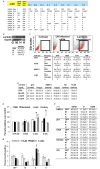Amyloidogenic light chains impair plasma cell survival
- PMID: 37381778
- PMCID: PMC10690890
- DOI: 10.3324/haematol.2022.282484
Amyloidogenic light chains impair plasma cell survival
Abstract
Systemic light chain amyloidosis (AL) is a clonal plasma cell disorder characterized by the deposition of misfolded immunoglobulin light chains (LC) as insoluble fibrils in organs. The lack of suitable models has hindered the investigation of the disease mechanisms. Our aim was to establish AL LC-producing plasma cell lines and use them to investigate the biology of the amyloidogenic clone. We used lentiviral vectors to generate cell lines expressing LC from patients suffering from AL amyloidosis. The AL LC-producing cell lines showed a significant decrease in proliferation, cell cycle arrest, and an increase in apoptosis and autophagy as compared with the multiple myeloma LC-producing cells. According to the results of RNA sequencing the AL LC-producing lines showed higher mitochondrial oxidative stress, and decreased activity of the Myc and cholesterol pathways. The neoplastic behavior of plasma cells is altered by the constitutive expression of amyloidogenic LC causing intracellular toxicity. This observation may explain the disparity in the malignant behavior of the amyloid clone compared to the myeloma clone. These findings should enable future in vitro studies and help delineate the unique cellular pathways of AL, thus expediting the development of specific treatments for patients with this disorder.
Figures





References
-
- Merlini G, Bellotti V. Molecular mechanisms of amyloidosis. N Engl J Med. 2003;349(6):583-596. - PubMed
-
- Obici L, Perfetti V, Palladini G, et al. Clinical aspects of systemic amyloid diseases. Biochim Biophys Acta. 2005;1753(1):11-22. - PubMed
-
- Desikan KR, Dhodapkar MV, Hough A, et al. Incidence and impact of light chain associated (AL) amyloidosis on the prognosis of patients with multiple myeloma treated with autologous transplantation. Leuk Lymphoma. 1997;27(3-4):315-319. - PubMed
-
- Rajkumar SV, Gertz MA, Kyle RA. Primary systemic amyloidosis with delayed progression to multiple myeloma. Cancer. 1998;82(8):1501-1505. - PubMed
Publication types
MeSH terms
Substances
LinkOut - more resources
Full Text Sources
Medical
Molecular Biology Databases

